Hand blending your soap gives you precise control over trace and texture that machines can't match. You'll avoid overmixing, preserve delicate patterns, and make real-time adjustments as you work. The manual process retains more nutritional benefits from oils and botanicals while creating a meditative, stress-relieving experience. It's also more economical, requiring less equipment and supporting sustainable practices. Discover how this traditional technique transforms soap making from simple chemistry into true artistic expression.
The Artisanal Touch: How Hand Blending Creates Superior Soap Textures
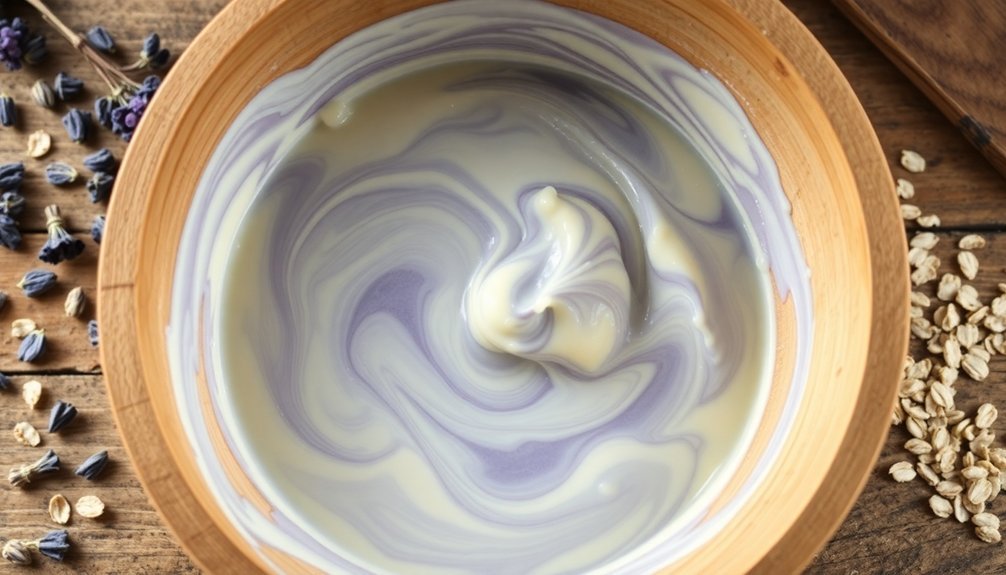
In the world of artisanal soap making, hand blending stands out as a technique that elevates ordinary soap into a sensory masterpiece.
You'll gain precise control over the soap's trace, which is critical for achieving those distinctive textures that set your creations apart.
When you blend by hand, you'll avoid overmixing—a common issue with machines that can destroy delicate patterns.
You can adjust your batter thickness in real-time, responding to how your specific recipe behaves under your careful touch.
Using simple tools like spoons, forks, and spatulas, you'll create varied textures that enhance both the visual appeal and tactile experience of your soap.
This personalized approach not only results in superior products but transforms soap making into genuine artistic expression.
For beginners and experienced soap makers alike, the medium trace phase offers an ideal consistency for many popular texturing techniques.
Master Your Ingredients: Complete Control With Manual Mixing Techniques
When you blend soap by hand, you're not just mixing ingredients—you're orchestrating a precise chemical symphony. Each oil demands a specific lye ratio for proper saponification, and manual mixing gives you the exactness needed to perfect this balance.
You'll gain the flexibility to adjust for variable oils on the fly, ensuring proper superfatting that prevents caustic residue in your final product. Hand blending helps you avoid over-mixing, which can ruin your soap's density and lathering properties. Recognizing proper soap trace consistency during manual blending allows you to accurately determine when your mixture has reached the ideal pudding-like state for molding.
Without machinery, you'll maintain tighter control over lye dispersion—critical for safety—while minimizing unwanted air bubbles that cause separation or cracking.
You can introduce colorants, fragrances, and decorative elements at precisely the right moment, preserving their integrity and creating truly customized soaps that reflect your artistic vision.
Preserving Nature's Goodness: Why Hand-Stirred Soap Retains More Benefits
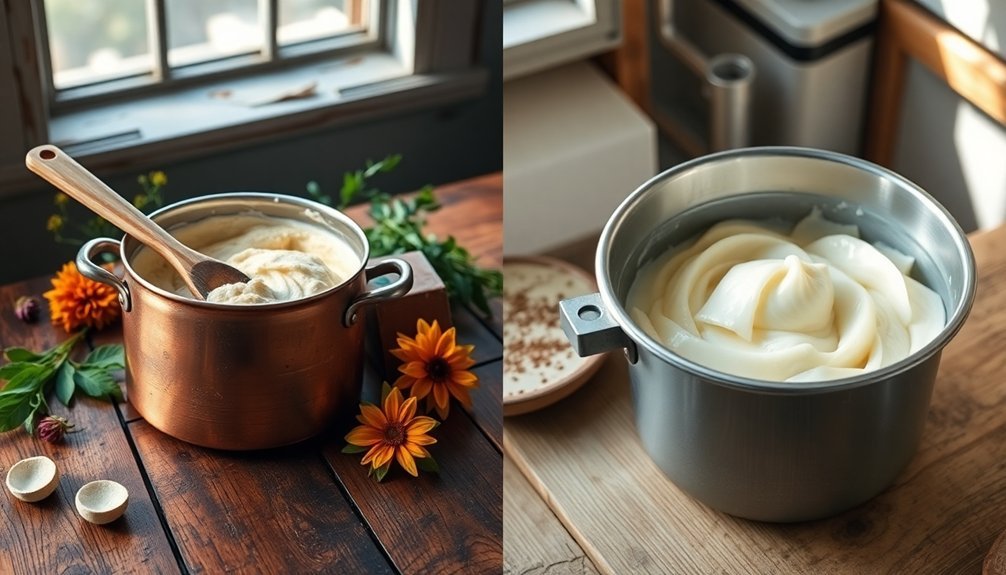
Hand-stirred soap preserves the inherent goodness of nature through careful manual blending that protects delicate ingredients.
When you hand-blend soap, you're maintaining the full nutritional profile of vegetable oils and botanical extracts that would otherwise be compromised by mechanical processes. The cold saponification process used in handmade soaps preserves therapeutic virtues of all ingredients, unlike machine mixing which often generates excessive heat.
Your hand-stirred creations retain higher levels of glycerin and essential vitamins because they're exposed to less heat during production.
This gentler approach guarantees the aromatherapeutic properties of pure essential oils remain intact, offering genuine skin benefits that mass-produced alternatives can't match.
You'll also notice the environmental advantages—hand-blended soaps typically use biodegradable ingredients, minimal packaging, and sustainable sourcing methods.
The result? A product that's not only better for your skin but also kinder to our planet.
The Economics of Hand Blending: Cost-Effectiveness Beyond the Price Tag
Beyond the environmental and health benefits, making soap by hand offers remarkable economic advantages that aren't immediately obvious from the price tag alone.
When you hand blend soap, you'll not only minimize waste through careful measurement but also greatly reduce your initial investment in equipment compared to machine operations.
Over time, you'll notice considerable cost savings as hand-blended products eliminate the need for multiple specialized commercial soaps. The process supports local economies and gives you complete control over your formulations. Hand-blended soaps provide similar benefits to high-end products at a fraction of the cost.
- No electricity required, reducing ongoing production costs
- Support local farmers and suppliers when sourcing ingredients
- Create customized products that address specific skin needs
- Reduce packaging waste that comes with store-bought alternatives
- Turn a personal passion into potential income through artisanal markets
Creative Expression Through Traditional Soap Making Methods
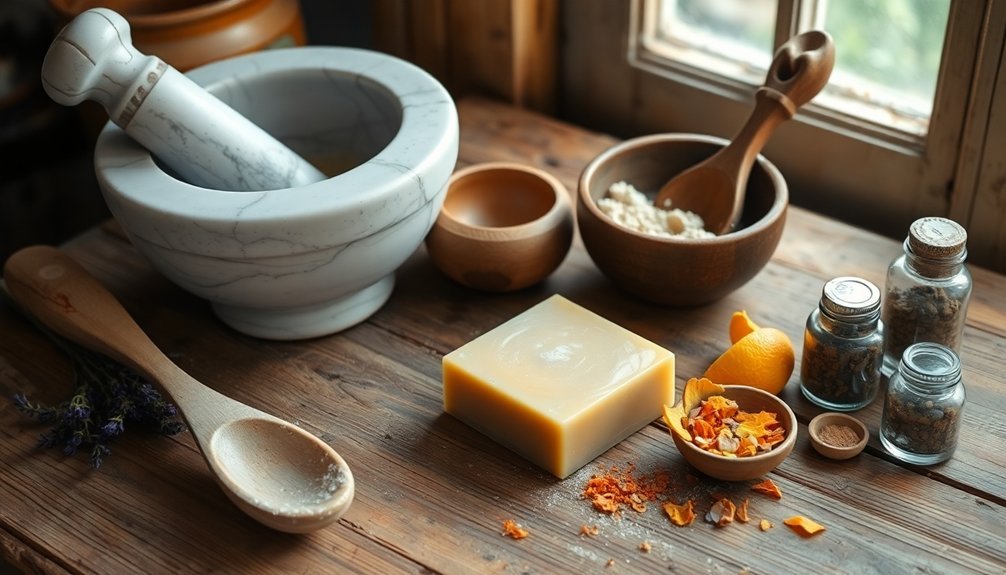
Traditional soap making transforms simple ingredients into canvases for personal expression and artistic achievement. When you hand blend soap, you'll discover unlimited potential for creating intricate swirls, layers, and patterns that machine mixing simply can't replicate.
Natural ingredients enhance your creative palette—botanical colorants like indigo and clay provide vibrant hues without synthetic additives, while coffee grounds and oatmeal offer textural variety. Hand blending allows for precise control when incorporating unique ingredients like avocado and honey that add nourishing properties. You're free to experiment with essential oil combinations, crafting unique scents that reflect your personal preferences.
This artistic freedom connects you to ancient traditions across cultures, preserving craftsmanship that's increasingly rare in our mass-produced world.
Whether you're using cold process for precise designs or hot process for rustic textures, hand blending empowers you to create functional art that delights all senses.
Ethical Production and Sustainability in Hand-Mixed Soap
While many consumers focus primarily on the aesthetic qualities of soap, ethical production and sustainability have become cornerstones of hand-blended soap making. When you choose hand-blended soaps, you're supporting transparency in ingredient sourcing and local economies. These soaps typically feature vegetable-based oils and essential oil fragrances instead of synthetic alternatives, markedly reducing environmental impact. The commitment to natural ingredients reflects the broader industry trend toward prioritizing skin-nourishing formulations that benefit both consumers and the environment.
- Small-batch production enables higher quality control with minimal waste
- Bar soaps require less packaging than liquid soaps, reducing plastic consumption
- Hand-blending uses less energy than large-scale manufacturing processes
- Local ingredient sourcing reduces transportation carbon footprints
- Artisanal soap makers often prioritize cruelty-free and vegan certifications
The mindful consumption that hand-blended soaps encourage aligns perfectly with growing consumer demand for products that honor both people and planet.
The Therapeutic Process: Finding Mindfulness in Traditional Soap Blending
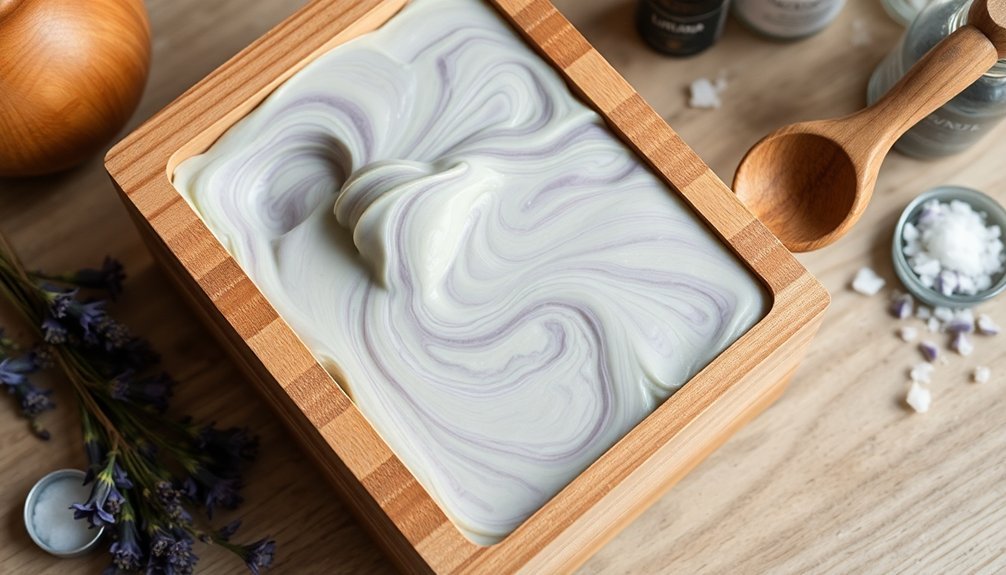
You'll find remarkable stress relief when you transform raw ingredients into aromatic soap through mindful hand-blending techniques.
Selecting each ingredient with intention—whether calming lavender or energizing citrus—turns the process into a form of self-care rather than just production.
When you approach soap making as a meditative practice, focusing on the sensory experience of scents and textures, you create not just soap but a moment of peace in your busy day. Hand-blending allows you to incorporate natural plant oils like jojoba and argan that restore your skin's barrier while creating your personalized soap formula.
Stress Relief Through Craft
Tranquility emerges naturally from the ancient practice of soap making, where the rhythmic motions of hand blending create a space for mindfulness. As you mix oils and lye, your focus narrows to the task at hand, offering a welcome escape from daily stressors. Working with natural ingredients allows you to create gentler soaps while connecting more deeply to traditional crafting methods.
The repetitive motions soothe your mind while engaging your body in purposeful creation.
- Repetitive stirring actions trigger a meditative state similar to yoga or prayer
- Complete attention to temperature and timing disconnects you from digital distractions
- Sensory engagement with fragrances and textures grounds you in the present moment
- Physical labor provides natural stress relief through movement
- Witnessing transformation from raw ingredients to finished soap delivers immediate satisfaction
Mindful Ingredient Selection
The art of selecting ingredients for hand-blended soap transforms a simple craft into a deeply therapeutic ritual. When you choose natural bases like coconut or olive oil, you're creating not just soap, but a moisturizing experience tailored to your skin's needs.
Essential oils offer more than pleasant scents—lavender calms while peppermint invigorates. Your selection of herbs adds both visual appeal and therapeutic benefits: nettle infuses green tones and anti-inflammatory properties, while cornflowers contribute antioxidants and beautiful blue specks. Yarrow flowers can be incorporated to provide antibacterial properties that naturally fight inflammation and promote healing for various skin conditions.
As you carefully weigh each ingredient, you're practicing mindfulness, considering how each element affects the final product. This thoughtful process extends to natural colorants like turmeric, connecting your creation to the earth while expressing your individuality through colors and patterns that reflect your emotional state.
Soapmaking Meditation Practice
While ancient soap makers likely didn't call their craft "meditation," the rhythmic stirring of oils and lye creates a natural mindfulness practice that modern artisans have rediscovered.
You'll find yourself fully present as you blend, noticing texture changes, temperature shifts, and the transformation happening beneath your hands.
This therapeutic process connects you to soapmaking traditions while offering modern benefits:
- Your mind calms as repetitive stirring motions create a meditative state
- Physical engagement grounds you in the present moment
- Sensory awareness heightens as you observe color changes and developing thickness
- Emotional balance emerges through the practice of patience and attention
- Stress melts away as you focus exclusively on the evolving mixture
The slower pace of hand stirring allows artisans to deeply connect with each stage of the saponification process as oils and lye gradually combine.
Frequently Asked Questions
How Long Does Hand Blending Take Compared to Machine Mixing?
You'll spend considerably more time hand blending compared to machine mixing. Hand blending can take up to an hour, while using a stick blender achieves trace within minutes, saving you considerable effort and time.
What Equipment Is Essential for Beginners in Hand Blending Soap?
You'll need a stainless steel whisk and spoon for mixing, a thermometer to monitor temperatures, and safety gear including goggles and rubber gloves to protect yourself during the soap-making process.
Can Hand Blending Prevent Common Soap Making Mistakes?
Yes, hand blending helps you avoid over-mixing, excessive air bubbles, and reaching trace too quickly. You'll better control texture changes and more easily create precise designs like swirls or layers in your soap.
Is Hand Blending Suitable for People With Physical Limitations?
If you have physical limitations, hand blending soap isn't ideal. You'll struggle with extended stirring, especially with arthritis or limited strength. Instead, consider using stick blenders, stand mixers, or adapted tools for easier soap making.
How Does Temperature Control Differ Between Hand and Machine Methods?
When hand blending, you'll need warmer temperatures (135-145°F) for effective tracing, while machine mixing works well at moderate temperatures (120-160°F). You'll have more temperature sensitivity with hand blending but faster results with machines.
In Summary
By choosing hand-blending over machine mixing, you're not just creating soap—you're practicing an art form. You'll gain precise control over textures, preserve delicate ingredients, and save on equipment costs. There's something deeply satisfying about connecting with this ancient craft, feeling ingredients transform beneath your hands. Whether for mindfulness, creativity, or sustainability, hand-blended soap carries your unique signature that machines simply cannot replicate.

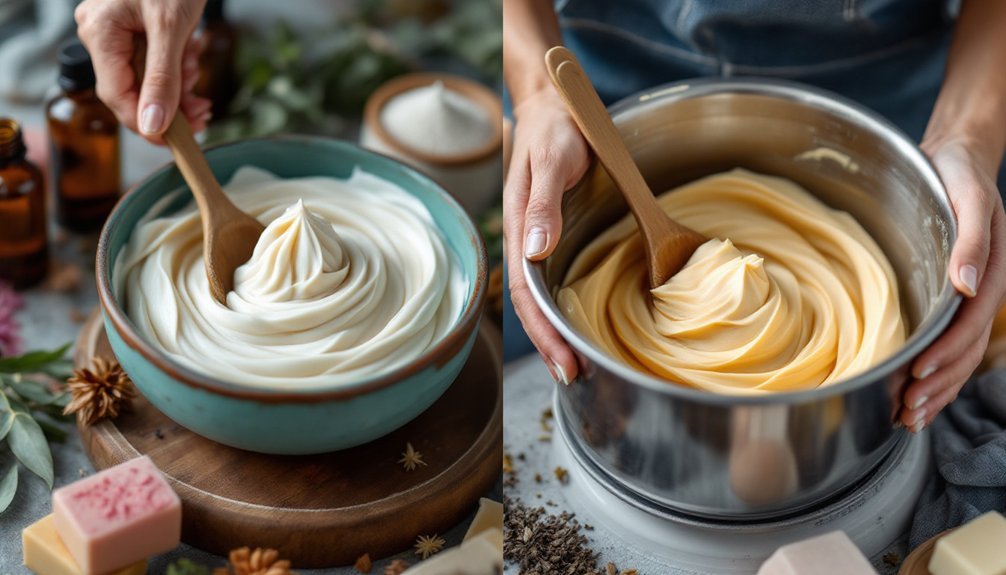



Leave a Reply